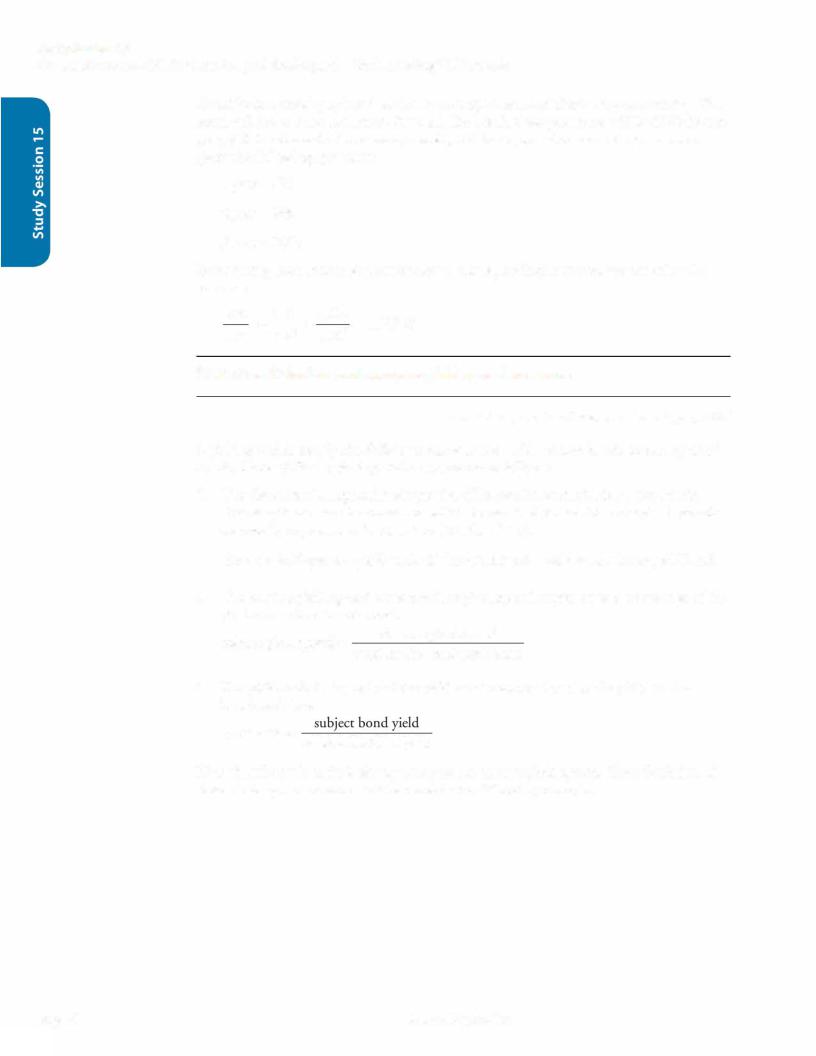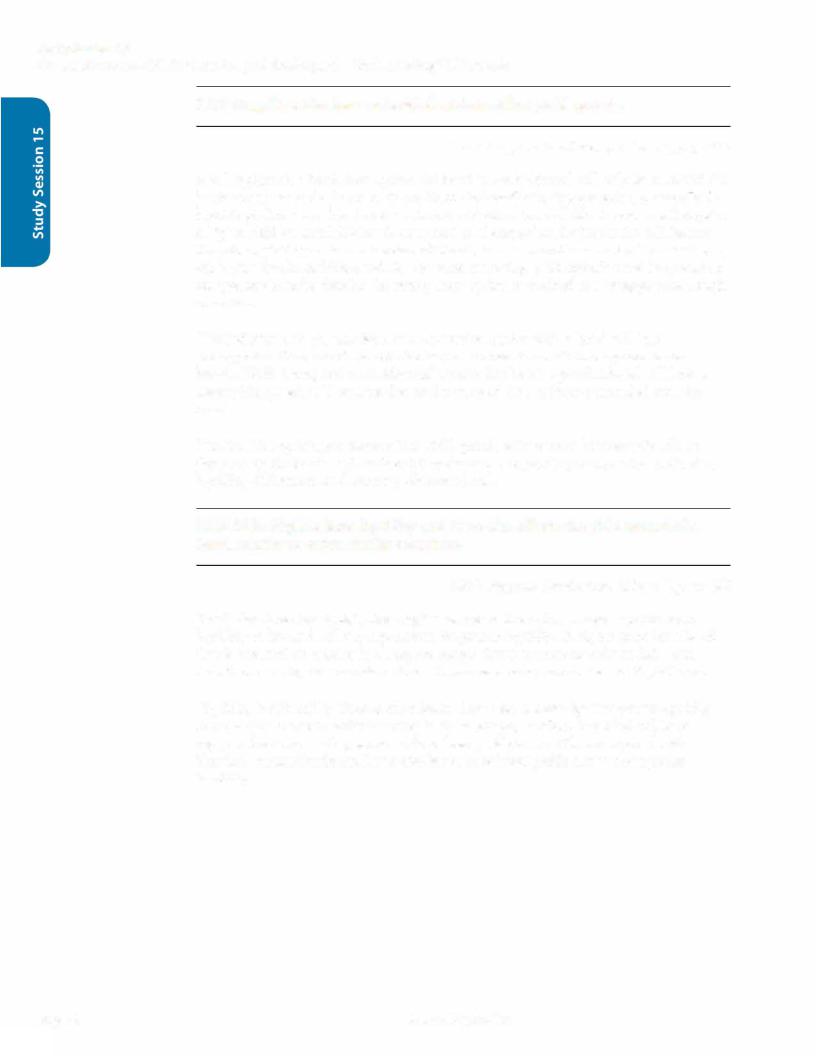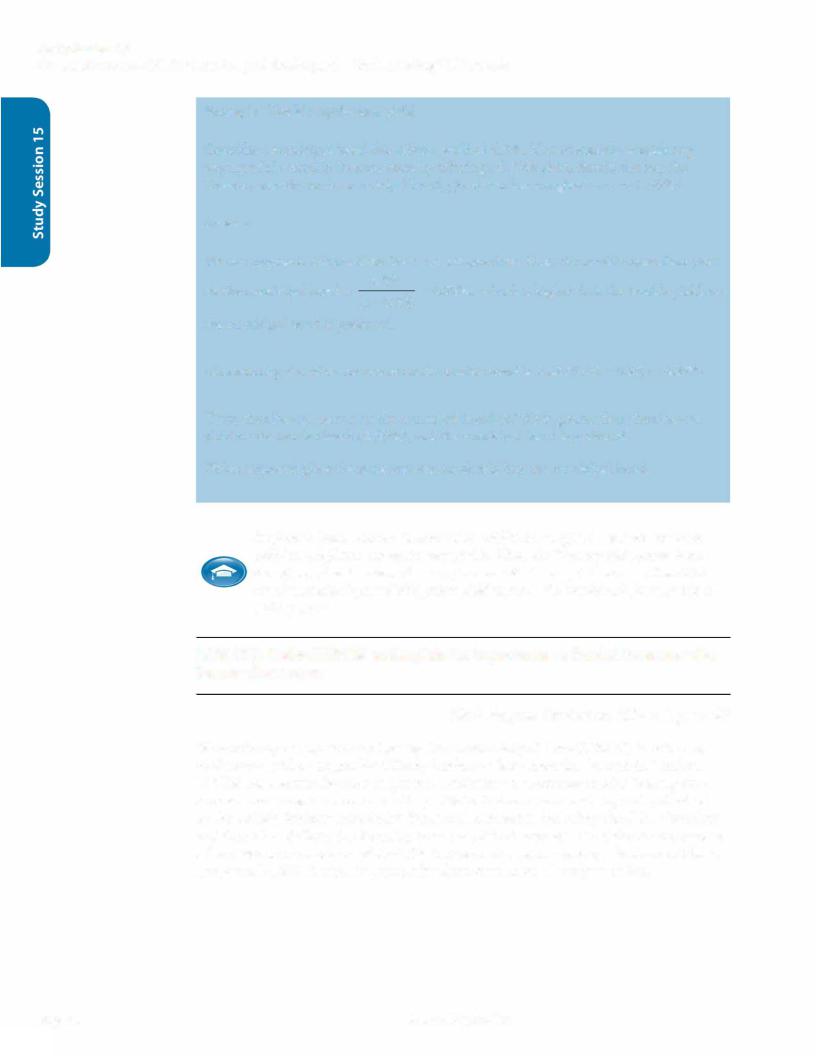
2013 CFA Level 1 - Book 5
.pdf
StudySession 15
Cross-Reference to CFA Institute Assigned Reading #55 - Understanding Yield Spreads
LOS 55.b: Describe a yield curve and the various shapes of the yield curve.
CFA® Program Curriculum, Volume 5,page 410
We have mentioned yield curves previously as just a plot of yields by years to maturity. For a view of a current Treasury yield curve and related information, you can look at www.bloombergcom/markets/rates/index. .html. The Treasury yield curve shows the yields for U.S. Treasury securities (bills, notes, and bonds) with maturities from three months to 30 years.
We use four general shapes to describe yield curves:
1 . |
Normal or upward sloping. |
|
2 . Inverted or downward sloping.
3.Flat.
4.Humped.
These four shapes are illustrated in Figure 1 .
Figure 1: Yield Curve Shapes
Yield |
Yield |
Yield |
Yield |
Humped
Inverted
Page 70 |
©2012 Kaplan, Inc. |





Study Session 15
Cross-Reference to CFA Institute Assigned Reading #55 - UnderstandingYield Spreads
Example: Computing yield spreads
Consider two bonds, X and Y. Their respective yields are 6.50% and 6.75%. Using bond X as the benchmark bond, compute the absolute yield spread, the relative yield spread, and the yield ratio for these bonds.
Answer:absolute yield spread = 6.75% - 6.50% = 0.25% or 25 basis points relative yield spread = 0.25% I 6.50% = 0.038 = 3.8%
yield ratio = 6.75% I 6.50% = 1 .038
The most commonly used yield spread is the absolute yield spread, even though it is the most simplistic. A shortcoming of the absolute yield spread is that it may remain constant, even though overall rates rise or fall. In this case, the effect of rising or falling rates on spreads is captured by the relative yield spread or the yield ratio.
For example, consider two yields that rise from 6.5% and 7.0% to 7.0% and 7.5%, respectively. The absolute yield spread remains constant at 50 basis points, while the relative spread falls from 7.69% to 7.14% and the yield ratio decreases from 1 .077 to 1 .071 .
LOS 55.f: Describe credit spreads and relationships between credit spreads and economic conditions.
CFA® Program Curriculum, Volume 5, page 418
A credit (or quality) spread is the difference in yields between two issues that are similar in all respects except for credit rating. An example of a credit spread is the difference in yields between long AA rated general obligation (GO) municipal bonds and long A rated GO munis (an intramarket spread as well). Obviously, these spreads show the effect of credit quality on yields and reveal the risk-return tradeoff the investor can expect
(i.e., how much added return an investor can earn by investing in issues with higher perceived credit risk) .
Credit spreads are related to the state of the economy. During an expanding economy, credit spreads decline as corporations are expected to have stronger cash flows. On the other hand, during economic contractions, cash flows are pressured, leading to a
greater probability of default and higher yields on lower-quality issues. When investors anticipate an economic downturn, they often sell low-quality issues and buy high-quality issues, including Treasuries. Thisflight to quality puts downward pressure on the prices of low-quality issues, raising their yields.
©20 12 Kaplan, Inc. |
Page 75 |

StudySession 15
Cross-Reference to CFA Institute Assigned Reading #55 - Understanding Yield Spreads
LOS 55.g: Describe how embedded options affect yield spreads.
CFA® Program Curriculum, Volume 5,page 420
A call option on a bond is an option the bond issuer holds and will only be exercised if it is advantageous to the issuer to do so. From the bondholder's perspective, a noncallable bond is preferred to a bond that is otherwise identical but callable. Investors will require a higher yield on a callable bond, compared to the same bond without the call feature.
Therefore, yield spreads to a benchmark bond, such as a similar maturity Treasury issue, are higher for the callable bond. By the same reasoning, yield spreads must be greater to compensate bondholders for the prepayment option embedded in mortgage passthrough securities.
The inclusion of a put provision or a conversion option with a bond will have the opposite effect; the choice of whether to exercise either of these options is the
bondholder's. Compared to an identical option-free bond, a putable bond will have a lower yield spread to Treasuries due to the value of the put feature included with the bond.
The fact that option provisions affect yield spreads is important because this tells us that spreads for bonds with embedded options are not purely premiums for credit risk, liquidity differences, and maturity (duration) risk.
LOS 55.h: Explain how liquidity and issue-size affects the yield spread ofa bond relative to other similar securities.
CFA® Program Curriculum, Volume 5, page 422
Bonds that have less liquidity have higher spreads to Treasuries. Investors prefer more liquidity to less and will pay a premium for greater liquidity. A higher price for a bond that is identical to another in all aspects except that it is more actively traded-and therefore more liquid-translates into a lower yield compared to the less liquid bond.
Liquidity is affected by the size of an issue. Larger issues normally have greater liquidity
because they are more actively traded in the secondary market. Empirical evidence suggests that issues with greater size have loweryieldspreads. When compared with identical but smaller issues, larger-size issues have lower yields due to their greater liquidity.
Page 76 |
©2012 Kaplan, Inc. |



Study Session 15
Cross-Reference to CFA Institute Assigned Reading #55 - UnderstandingYield Spreads
A funded investor is one who borrows to finance an investment position. The importance of LIBOR in this context is as a measure of the funding costs because the loans to finance the investment are most often floating-rate loans or short-term loans where the reference rate is published LIBOR. Recall that floating-rate loans are based on a reference rate plus a margin. A funded investor with a borrowing rate of 2-month (60-day) LIBOR + 40 basis points would have a borrowing cost (annualized) of 2.6% when 2-month LIBOR is quoted at 2.2%. The profits of such a funded investor would depend on his or her ability to earn greater than a 2.6% annual rate on the investments funded in such a manner.
©20 12 Kaplan, Inc. |
Page 79 |
